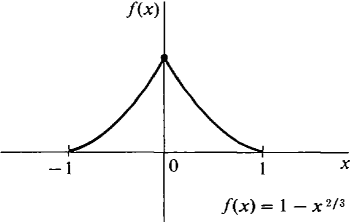| The ebook Elementary Calculus is based on material originally written by H.J. Keisler. For more information please read the copyright pages. |

|

Home  Continuous Functions Continuous Functions  Properties of Continuous Functions Properties of Continuous Functions  Examples Examples  Example 5: Example 5: |
|






|
|
Example 5:
f(x) = 1 - x2/3, a = -1, b = 1. Then f(-1) = f(1) = 0, and f'(x) = -⅔x-1/3 for x ≠ 0. f'(0) is undefined. There is no point c in (-1, 1) at which f'(c) = 0. Rolle's Theorem does not apply in this case because f'(x) does not exist at one of the points of the interval (-1, 1), namely at x = 0. In Figure 3.8.15, we see that instead of being horizontal at a point in the interval, the curve has a sharp peak.
Figure 3.8.15 Rolle's Theorem is useful in finding the number of zeros of a differentiable function f. It shows that between any two zeros of f there must be one or more zeros of f'. It follows that if f' has no zeros in an interval I, then f cannot have more than one zero in I.
|
|
Home  Continuous Functions Continuous Functions  Properties of Continuous Functions Properties of Continuous Functions  Examples Examples  Example 5: Example 5: |
|
Last Update: 2006-11-15


